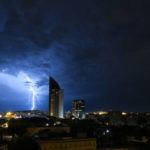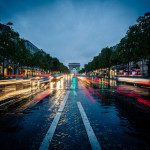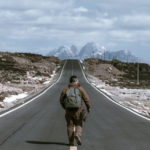I see photographers making these five common composition mistakes all the time. It’s part of the learning process and every photographer works their way through it.

What common composition mistakes do you see photographers make? Let us know in the comments.
1. Using the rule of thirds all the time
There’s nothing wrong with the rule of thirds as long as you recognize that it’s only a guideline (it shouldn’t really be called a rule). There are times when it works, and times when you need to move beyond it and look for different ways to compose your photos.
Deeper concepts are involved, such as balance, use of line, tonal contrast and negative space. Once you start to understand what these are, and how to use them, the composition of your photos will get stronger.
2. Not learning from other photographers
There are no absolutes in composition. There are always different approaches, new ways to compose images, new ways of seeing. The worst thing you can do is think that there is nothing new to learn. I’ve been taking photos for over 20 years and I’m still learning, especially from photographers who are good at composition. It’s a lifelong journey, and it’s impossible to know everything there is about seeing and composition.
Go and study the work and ideas of the photographers you admire the most. How do they compose their photos? How do they balance subject, light and composition? Which lenses do they use? What aperture settings? Analyze it all and then apply what you learn to your own photos.
This point is related to the first. If you think that all you have to do is use the rule of thirds then you have only scratched the surface of composition. If you stop there, and don’t move on, then you will never learn how to make more beautiful, compelling images.
3. Using a zoom lens without thinking
Zoom lenses are wonderful. They are convenient and versatile. However, they don’t teach you much about the effect of focal length on composition.
Even the humble 18-55mm kit lens is a moderate wide-angle at 18mm, a normal lens at around 30mm and a short telephoto at 55mm. If you move around between these settings without thinking, you will never learn about the different lens types and their effect on composition.
My preference is for primes. When you use a prime lens you really learn how to get the best from that focal length. You’ll learn what happens to line and perspective when you move closer to your subject, or further away. You’ll learn the strengths of that focal length and its weaknesses. Creativity loves constraints, and you will find ways to use that focal length creatively that would never have occurred to you otherwise.
If you have a zoom lens, try this exercise. Pick a focal length and stick with it for a day, a week or a month. Apply masking tape to the zoom ring to keep it in place if you have to. Then go and learn how that focal length works.
This photo was taken with a 35mm lens on my Fujifilm X-T1. It has become one of my favorite lenses, especially for walking around with and taking photos. I’ve learned a lot about this lens by using it so much.

35mm
4. Not getting close enough to your subject
Robert Capa is often quoted as saying, “If your photos aren’t good enough, then you’re not close enough.”
Here are a couple of things to think about.
Are you physically close enough to your subject? Sometimes you need to get closer to your subject and fill the frame, especially with wide-angle lenses. If you are too far away then the photo loses impact.
Are you emotionally close enough to your subject? For example, if you are photographing a landscape that means something to you personally, that you have connected with or identified with on a deeper level than just thinking it’s pretty, then you will take deeper, more intimate photos of it.
It’s the same with people. If you identify with and relate to somebody on a personal level, if you are genuinely interested in the people that you photograph, then you will make better portraits of them.
I made this portrait of artist Chris Meeks during a visit to his studio. We spent several hours talking about art and life as he showed me how he created his artwork. This created a rapport that came across in the photos.
5. Not giving your subject room to breathe
Having said that, there are times when you need to give your subject room to breathe. You need to provide a space in the frame for your subject to occupy. This is called negative space.
How do you know when you need to get closer to your subject, or when you need to give it some negative space? There isn’t an easy answer. My advice is to follow your gut. What does your instinct tell you? The more you learn about composition, the easier it gets to rely on your instinct which is really your subconscious mind processing the knowledge you have absorbed about composition and letting you know how it feels.
Work your subject. Take a variety of photos—some closer, some farther away (with negative space)—and analyze them afterwards. You’ll soon learn what works and what doesn’t.
The first photo above is of the famous and much photographed Wanaka Tree (New Zealand photographers will know what I’m talking about). I left space around it, rather than use a longer focal length, to show the tree in its mountainous environment.
About the Author:
My name is Andrew S. Gibson and I’m here to help you take better photos. I’ve taken photos in over 60 countries, studied for a degree in photography and worked as Technical Editor for EOS magazine. Now I’m a freelance writer and I make a living writing and teaching people about photography. In recent years I’ve lived in the UK, China and New Zealand, which is now my home.
Like This Article?
Don't Miss The Next One!
Join over 100,000 photographers of all experience levels who receive our free photography tips and articles to stay current:







Can’t really agree with the zoom lens business. I can’t tell you how many times I’ve gone wide trying to get as much of a great scene in as possible, seeing the distortion, and realizing “Uh, uh, that’s not going to work.” Then I go longer. It’s one of the greatest advantages digital has over film; it’s so easy to stitch frames in panoramas and “false medium formats,”—heck, I’ve probably shot false large format already because I can’t back up far enough to avoid wide-angle distortion!
Don;t see anything wrong with it. Looks pretty neat to me. Art (and photography) is in the eye of the beholder.
Surely one can do good images without following the “rules” by rote. This group of images, to me, is successful in just one out of three. I like the image of the tree just the way it is; the high key effect is very appealing, and I’m not troubled by the composition.
The image of the two girls taking phone pictures is not pleasing to me — this is not a flattering pose for her legs, and the composition draws my eye out to the left, with nothing there to see. The girls should be an attractive subject in their own right, or the composition should lead your eye to whatever it is that is interesting them.
The welder/sculptor is lacking in several ways — again, the composition leads my eye out to the right. I agree he needs room to breathe, but why not give him some space to the right, beyond his torch? The left blank space does nothing for the composition except to make me want to get closer and pan right a bit.
IMHO: I would have liked the limbs and leaves of the tree to be darker. More contrast with the fog.
There is another perspective to the rule of 3rds using the Fibonacci sequence (Golden Means Spiral) that makes you think differently about subject placement and the flow of the image. I have been having fun experimenting with this technique and its exciting to see how many times this pattern is found in a scene or even close up macro photography. Love in Light, Carlton